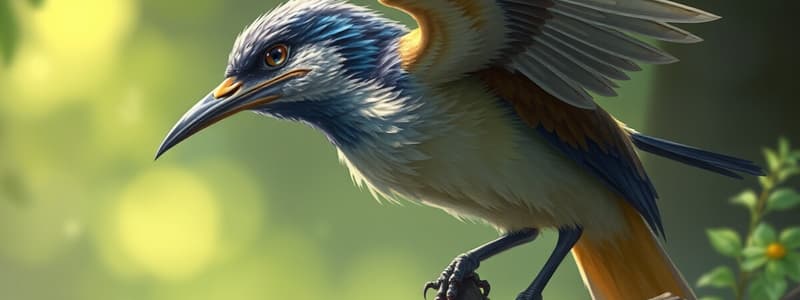Podcast
Questions and Answers
What unique characteristic is shared by all members of the class Aves?
What unique characteristic is shared by all members of the class Aves?
feathers
Why do all birds have the same basic body plan?
Why do all birds have the same basic body plan?
Many adaptations for flight
What are the major characteristics of the class Aves?
What are the major characteristics of the class Aves?
A single occipital condyle, a furcula, single middle ear bone, lower jaw with multiple bones, excrete uric acid, endothermic, a horny beak with no teeth
Are birds ectothermic or endothermic?
Are birds ectothermic or endothermic?
Which line of dinosaurs gave rise to the birds?
Which line of dinosaurs gave rise to the birds?
What is the importance of the fossil of Archaeopteryx?
What is the importance of the fossil of Archaeopteryx?
Describe the structure of a feather.
Describe the structure of a feather.
Feathers are homologous to what reptile structure?
Feathers are homologous to what reptile structure?
What adaptations for flight have evolved in birds?
What adaptations for flight have evolved in birds?
What makes bird respiration so efficient?
What makes bird respiration so efficient?
Describe some ways in how the bird skeleton is adapted for flight.
Describe some ways in how the bird skeleton is adapted for flight.
Describe how the toe-locking (perching) mechanism works in birds.
Describe how the toe-locking (perching) mechanism works in birds.
Describe reproduction in birds.
Describe reproduction in birds.
How do male and female birds reduce the weight of their reproductive systems?
How do male and female birds reduce the weight of their reproductive systems?
Define the terms 'polygynous' and 'polyandrous'.
Define the terms 'polygynous' and 'polyandrous'.
What are some advantages of monogamy that are seen in most birds?
What are some advantages of monogamy that are seen in most birds?
Why do most birds migrate?
Why do most birds migrate?
Flashcards are hidden until you start studying
Study Notes
Unique Characteristics of Aves
- All birds possess feathers, the defining characteristic of the class Aves.
Adaptations for Flight
- Birds exhibit a standardized body plan due to numerous adaptations that facilitate flight.
- Features include a single occipital condyle (contrasting with mammals that have two) and a furcula, or wishbone.
Major Characteristics of Aves
- A single middle ear bone (mammals have three).
- The lower jaw consists of multiple bones, whereas mammals have only one.
- Birds excrete uric acid instead of urea as seen in mammals.
- Birds are endothermic, generating and maintaining constant body heat.
- Distinctive beaks made of hard material without teeth.
Archaeopteryx
- Archaeopteryx, dating back to about 150 million years ago in the Jurassic period, is the oldest known bird.
- This fossil provides critical evidence linking birds and reptiles, showcasing transitional characteristics.
Feather Structure
- Contour feathers are predominant, featuring a hollow quill and a shaft from which barbs extend.
- Barbules are small extensions from the barbs that interlock to maintain feather structure.
Feather Composition
- Feathers are made of protein keratin, similar to reptilian structures.
Flight Adaptations
- Lightweight feathers and air cavities in bones enhance flight.
- Birds have fused collarbones and a keeled sternum; flexible necks enable maneuvering as wings are less mobile.
Efficient Respiration
- Birds benefit from a specialized respiratory system that retains air within lungs and trachea, maximizing oxygen exchange.
Skeletal Adaptations for Flight
- Most vertebrae are fused (except cervical ones), adding rigidity necessary for flight.
- Unique in having fused collarbones and a keeled sternum.
Perching Mechanism
- A toe-locking mechanism enables birds to perch; calf muscles connect to toes and talons, causing contraction and stability.
Reproductive Traits
- Most male birds lack a penis; copulation occurs via cloacal contact.
- Internal fertilization with amniotic eggs containing high yolk and hard shells.
- Females can store sperm for up to a year.
Weight Reduction in Reproductive Systems
- To lessen weight for flight, the right oviduct and ovary are underdeveloped in most birds.
- Male testes increase in size during mating seasons.
Reproductive Strategies
- Polygyny: Males mate with multiple females; females care for the young, aiding independent offspring.
- Polyandry: Females mate with multiple males, producing more eggs, advantageous in high predation environments.
Advantages of Monogamy
- Males that mate monogamously often assist in nesting care, allowing females to forage effectively.
Migration Reasons
- Birds migrate to escape temperature extremes, access diverse food sources, and seek ample living space.
Studying That Suits You
Use AI to generate personalized quizzes and flashcards to suit your learning preferences.




